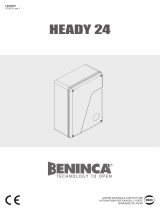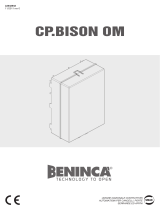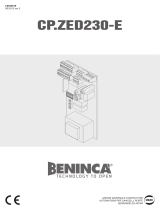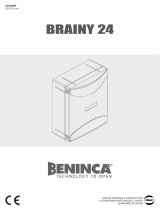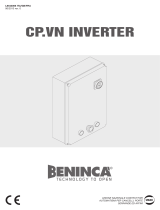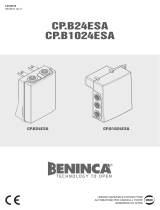Rimuovere le 4 viti A , quindi rimuovere il coperchio B
Sul fondo del contenitore centrale sono presenti 4 predisposi-
zioni (C) da rompere con un cacciavite.
Posare il fondo alla parete e segnare i 4 punti di foratura.
Eseguire 4 fori ed inserire 4 tasselli (E), fissare la centrale con le
4 viti D. Tasselli e viti sono fornite in dotazione.
Per il passaggio dei cavi di collegamento è prevista sul fondo
del contenitore una sede (F) da aprire con un cacciavite per il
fissaggio di un raccordo per tubo corrugato.
Remove the 4 screws A and then remove cover B
There are 4 set-ups (C) present on the base of the control unit
container, which must be broken using a screwdriver.
Place the base on the wall and mark the 4 drilling points.
Make the 4 holes and insert the 4 plugs (E), fix the control unit
with the 4 screws D. Plugs and screws are supplied.
There is a seat (F) on the base of the container for the passage of
the connection cables. This must be opened using a screwdriver
in order to fix a fitting for the corrugated pipe.
Entfernen Sie die 4 Schrauben A und nehmen Sie Deckel B ab.
Im Boden des Hauptgehäuses befinden sich 4 vorbereitete Öff-
nungen (C), die mit einem Schraubenzieher aufzubrechen sind.
Halten Sie den Boden an die Wand und zeichnen Sie die 4 Boh-
rungen an.
Führen Sie die 4 Bohrungen aus und setzen Sie 4 Dübel (E) ein.
Fixieren Sie die Steuerung mit den 4 Schrauben D. Dübel und
Schrauben werden mitgeliefert.
Zur Einführung der Anschlusskabel befindet sich im Boden des Ge-
häuses eine Halterung (F) für die Befestigung eines Wellrohranschlus-
ses, die mithilfe eines Schraubenziehers geöffnet werden muss.
Enlever les 4 vis A puis enlever le couvercle B
Au fond du boîtier de la centrale se trouvent 4 ouvertures spéciales
(C) qu’il faut creuser à l’aide d’un tournevis.
Appuyer le fond du boîtier contre le mur et marquer avec 4 signes
les points de perçage.
Percer les 4 trous et insérer les 4 chevilles (E), fixer la centrale avec
les 4 vis D. Les chevilles et les vis sont fournies en dotation.
Pour passer les câbles de branchement, une ouverture spéciale (F)
à creuser à l’aide d’un tournevis a été prévue dans la partie basse
du boîtier pour fixer le raccord du tuyau annelé.
Quite los 4 tornillos A, entonces quite la cubierta B
En el fondo de la caja central hay 4 predisposiciones (C) que
hay que romper con un destornillador.
Apoye el fondo a la pared y marque los 4 puntos de perforación.
Realice los 4 agujeros e introduzca los 4 tacos (E), fije la central
con los 4 tornillos D. Se proporcionan los tacos y los tornillos.
Para el pasaje de los cables de conexión está previsto en el fon-
do de la caja un alojamiento (F) que hay que abrir con un destor-
nillador para la fijación de un racor para tubo corrugado.
Wykręć śruby A i ściągnij pokrywę B.
Śrubokrętem zrób 4 otwory (C)na tylnej ściance skrzynki. Przyłóż
skrzynkę do ściany i zaznacz 4 miejsca na otwory. Wywierć ot-
wory, wsadź 4 kołki(E), przykręć skrzynkę wkrętami (D).
Kołki i wkręty są w zestawie. Na dolnej ścianie skrzynki jest mie-
jsce do wprowadzenia przewodów. Śrubokrętem należy zrobić
tam otwór na dławik.









